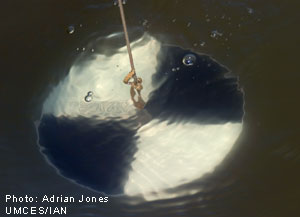Scientists use a Secchi disk, a simple and inexpensive instrument, for measuring water clarity. Pietro Angelo Secchi, an Italian astronomer, invented the Secchi disk in 1865. A Secchi disk is circular with alternating black and white quarters. It is mounted on a line and lowered into the water until the pattern on the disk is no longer visible. The distance between the disk and the water's surface is referred to as the "Secchi depth" and is as a measure of clarity, where larger distances indicate clearer water. Although relatively easy to make, Secchi disk measurements can be affected by observer bias, sun glare, or shadow. This is why new practitioners should compare their estimates with those of experienced scientists (called standardization) before carrying out measurements.

